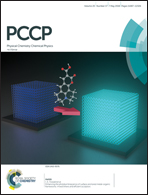Unifying theoretical framework for deciphering the oxygen reduction reaction on platinum†
Abstract
Rapid conversion of oxygen into water is crucial to the operation of polymer electrolyte fuel cells and other emerging electrochemical energy technologies. Chemisorbed oxygen species play double-edged roles in this reaction, acting as vital intermediates on one hand and site-blockers on the other. Any attempt to decipher the oxygen reduction reaction (ORR) must first relate the formation of oxygen intermediates to basic electronic and electrostatic properties of the catalytic surface, and then link it to parameters of catalyst activity. An approach that accomplishes this feat will be of great utility for catalyst materials development and predictive model formulation of electrode operation. Here, we present a theoretical framework for the multiple interrelated surface phenomena and processes involved, particularly, by incorporating the double-layer effects. It sheds light on the roles of oxygen intermediates and gives out the Tafel slope and exchange current density as continuous functions of electrode potential. Moreover, it develops the concept of a rate determining term, which should replace the concept of a rate determining step for multielectron reactions, and offers a new perspective on the volcano relation of the ORR.



 Please wait while we load your content...
Please wait while we load your content...